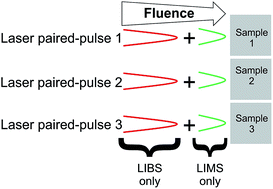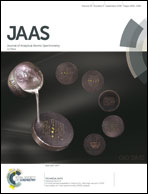Isomer discrimination in condensed phase by laser-induced breakdown spectrometry and laser-ionization mass spectrometry using a tailored paired-pulse excitation scheme
Abstract
A new excitation scheme for direct analysis of organic compounds in condensed phase is described. The approach involves the combined use of two laser-ablation based techniques (laser ionization mass spectrometry (LIMS) and laser induced breakdown spectrometry (LIBS)) within a common experimental setup to simultaneously obtain atomic and molecular information capable of discriminating organic isomers. An initial laser pulse tailored to induce gentle excitation with limited fragmentation is followed by a second pulse at a specific fluence above the plasma formation threshold. Under a simultaneous ion-photon detection scheme, this configuration allows the recording of optimized optical emission and mass spectra. Despite the consecutive excitation, the low fluence conditions of the first pulse assure the sample integrity for the LIBS analysis of the successive pulse. The improved capabilities of the new excitation scheme have been demonstrated in the analysis of three dinitrotoluene isomers (2,3-, 2,4- and 2,6-), where the information provided by LIMS and LIBS is processed by a discriminant function analysis method to establish discrimination criteria for the three nitro aromatic isomers based on differences in spectral features.



 Please wait while we load your content...
Please wait while we load your content...